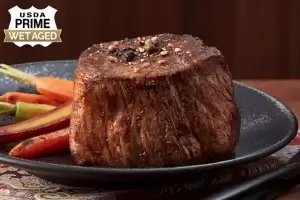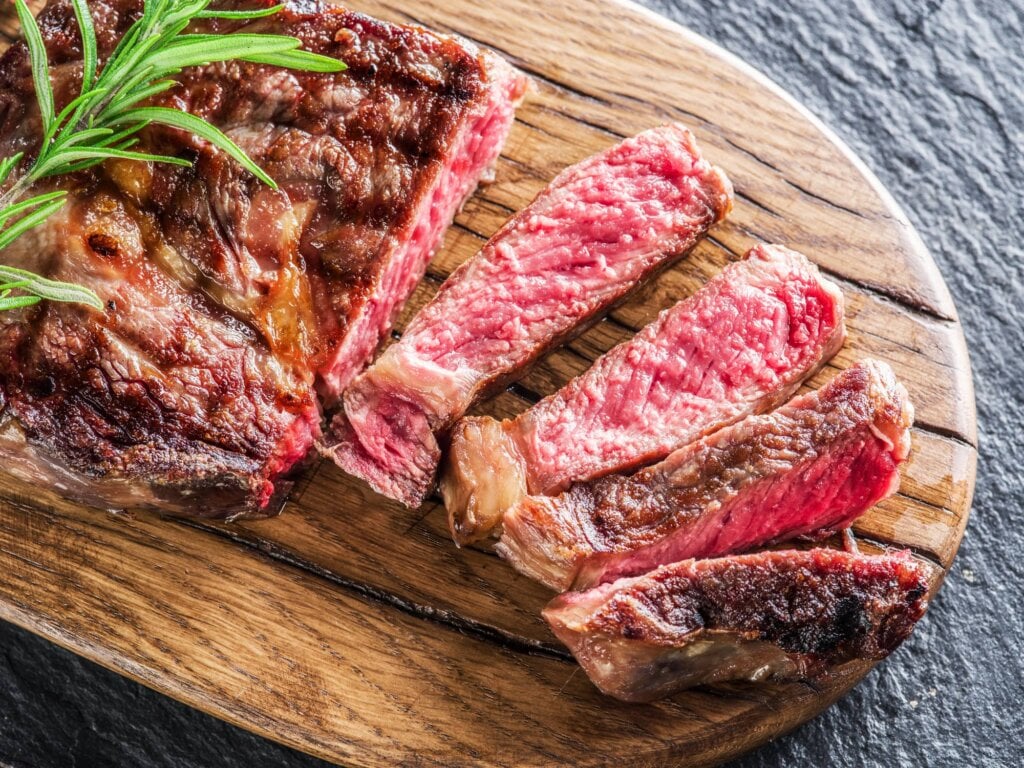
Grilled has long been one of the most popular ways to enjoy ribeye steak. This yummy cut of steak is tender and full of flavor, and the grill only enhances its texture and taste. In fact, some say that the grilled sear on ribeye makes it taste even better than it would when cooked on a pan.
Ready to learn how to grill ribeye like a pro? Keep reading this guide.
How To Choose A Ribeye
A crucial piece of the puzzle in grilling a delicious ribeye is choosing the right steak to start with. While you can find some budget-friendly ribeye steaks in your local supermarket, they may not be the high-quality steak you were hoping for.
The best ribeye steaks for grilling are labeled as USDA Prime or Wagyu. USDA Prime is the highest grade of ribeye steak the USDA offers. Wagyu is considered the cream of the crop in the steak world, denoting steaks that come from Wagyu beef and are among the highest overall quality.
Also, consider wet-aged vs dry-aged. Wet-aging is a faster process that results in more moisture within each ribeye steak. Dry-aging is a longer process that breaks down enzymes to create a super tender steak. One option isn’t necessarily better than the other, but finding either wet-aged or dry-aged steak can boost the yum factor of ribeye.
Bone-In or Boneless?
Ribeye is available with the bone in or boneless, and both kinds have their perks. Many steak enthusiasts believe bone-in ribeye carries a richer flavor since the bone helps retain juices (although whether it actually is more flavorful is quite debated in the steak community!). The bone also insulates the meat as it cooks, which can help get a more uniform cook throughout the inside.
On the other hand, boneless ribeye can cook faster than bone-in, and it’s easier to handle on a plate, since you don’t have to cut around a bone. In terms of convenience, boneless usually wins.
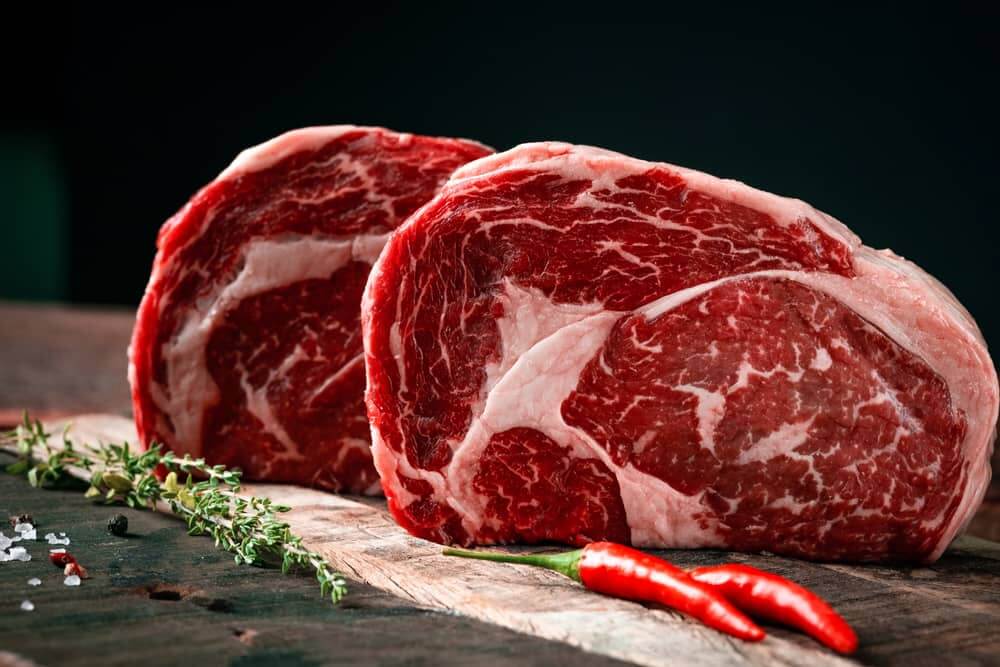
The Preparation
Before you fire up the grill, give yourself time to set things up properly. Clean and lightly oil your grill grates to keep the steak from sticking. Also, have a digital thermometer ready so you don’t need to guess doneness, and prepare a foil-lined plate for resting once the steaks come off the heat. Next, you’re ready to season the steak.
Seasoning
Salt the steak generously and let it sit at room temperature for about 45 minutes before placing it on the grill. This lets the salt create a brine that helps the ribeye crisp when cooked. Add a sprinkle of pepper and your other favorite spices right before grilling.
Grilling Ribeye on a Gas Grill
Turn the heat up to high — about 500 degrees — on your gas grill. If your grill offers variable temperatures, turn one side to 500 degrees and the other side to low, or 275 degrees. Allow to heat completely for 3-5 minutes before adding steaks.
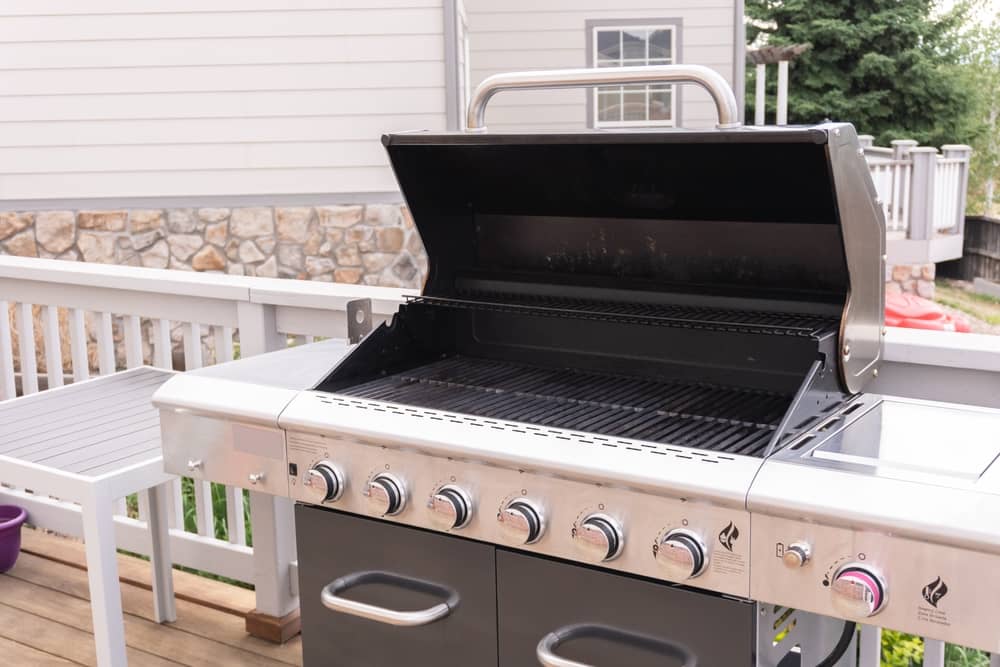
Grilling Ribeye On a Charcoal Grill
Place coals in the bottom of the grill stacked into a mound, which helps distribute the heat throughout the coals quicker. Spray lighter fluid on the coals and light with a match. After several minutes, the coals should turn white, marking them as ready to cook. Evenly move the coals around on the bottom of the grill before cooking.
Alternatively, you can use a chimney starter to light the coals by placing a couple of crumpled pieces of newspaper at the bottom of the chimney starter and coals on top. Light the newspaper with a lighter or match and allow it to sit for several minutes until the coals turn white.
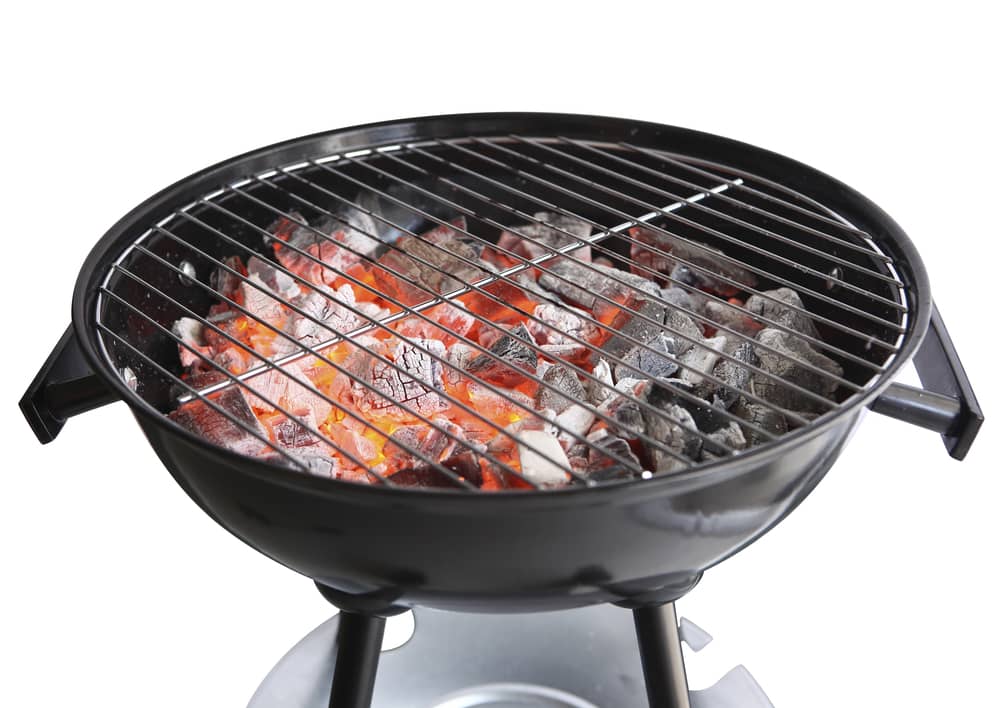
Grilling Ribeye On a Wood-Fired Grill
Cooking ribeye over a wood fire adds a smoky depth similar to the charcoal grill, but with a little more control over the flavors you infuse into the meat. You can choose whichever wood you like most, but hardwoods like oak, hickory, and mesquite work really well with ribeye, adding a nice, bold flavor.
Build a steady bed of hot coals with your choice of wood pellets. Once the flames die down, set the ribeye directly over the hottest area to quickly sear each side. Then, move the steaks to a cooler area of the grill to finish cooking to your desired temperature.
Ribeye Cooking Temperatures and Doneness
Ribeye grilling times vary depending on the steak’s thickness and your specific grill. The average ribeye is about 1 ½ inches thick. These thicker steaks will usually take between 12-16 minutes to cook to medium-rare. Then, you’ll need 5-10 minutes to rest the steak before eating.
For a thinner steak that’s about one inch thick, plan on leaving it on the grill for 8-12 minutes to reach medium-rare. For medium or medium-well, you’ll add 1-3 minutes to each time.
Final Temperature
We always recommend medium-rare for best results with this cut, but the following chart outlines the different doneness levels you can achieve with grilled ribeye steak. For each doneness level, be sure to remove the steak from the grill before it reaches the goal temperature, as indicated by the temperature in the middle column.
| Doneness | Temperature to Remove from Heat | Final Temperature |
| Medium-rare | 125-130℉ | 130-135℉ |
| Medium | 135-140℉ | 140-145℉ |
| Medium-well | 145-150℉ | 150-155℉ |
| Well-done | 155-160℉ | 160-165℉ |
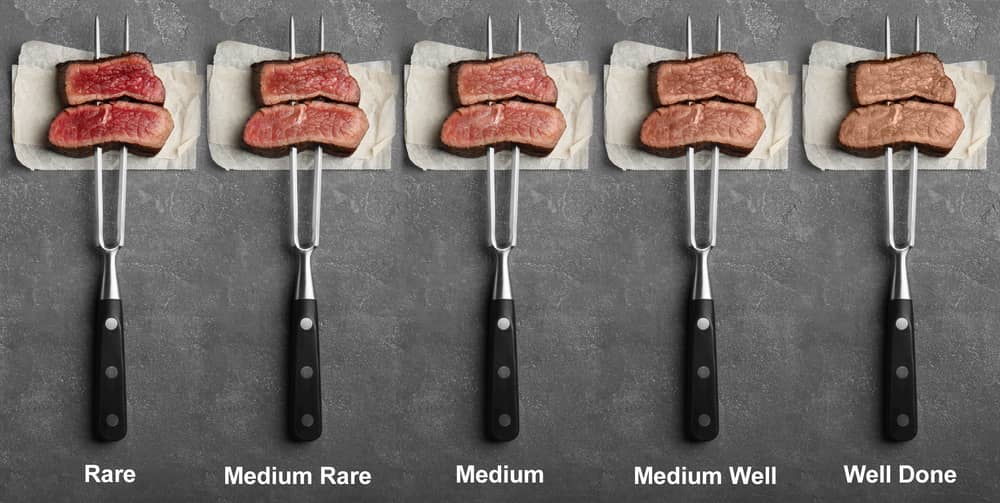
Medium Rare Ribeye
Medium-rare is the ideal goal for grilling ribeye because it gives the fat enough time to break down and distribute through the meat but without risking its tender texture. You’ll get prime flavor and texture in each bite with a perfect medium-rare ribeye.
For this level of doneness, you’ll cook the steak for about 12-16 minutes, or until a meat thermometer inserted into its thickest part reaches 125℉ (130℉ if you’d prefer it to be a little closer to medium). Then, let the steak rest for 5-10 minutes on a plate tented with foil until it reaches a final temperature of 130-135℉.
Ribeye Grilling Tips
Consider the following tips to grill a perfect and delicious steak every time:
- Only flip once: Flipping steak too much on the grill can cause it to stick to the grates and not get a good sear on either side. Instead, flip it just once about halfway through the cooking process.
- Keep a watchful eye: Some grills can be finicky — especially charcoal ones — so keep an eye on your grill and steak to make sure the flames stay steady and your steak isn’t overcooking.
- Use a thermometer: Use a digital meat thermometer to judge whether your steak is done. Other methods aren’t as reliable for getting your ideal cook.
Perfect Grilled Ribeye Recipe
Ingredients
- 2 ribeye steaks
- kosher salt, to taste
- 2 tbsp olive oil
- 1 tbsp freshly ground black pepper
Instructions
- Remove the steak from the refrigerator, and season generously with salt on both sides. Then, rest at room temperature for 45 minutes. Preheat the grill to 450-500 degrees. Brush 1 tbsp olive oil on the steaks and season the steaks with salt and pepper, if desired
- Place the ribeye steaks on the grill. Let sear for about 2-4 minutes until a golden-brown crust begins to form. Flip to the other side and sear for another 2-4 minutes.
- Use a digital meat thermometer to check the internal temperature of the thickest part of the meat. If more time is necessary, move the steaks to a low-heat zone of the grill to let the steak cook for another 2-5 minutes.
- Remove steaks from the grill and rest at room temperature on a plate tented with foil for 5-10 minutes before serving.
What to Serve with Grilled Ribeye
Ribeye is hearty on its own, but the right sides can make it part of a next-level meal. Classic pairings like baked potatoes, garlic mashed potatoes, or a Caesar salad are always reliable choices that balance the richness of the steak. Grilled vegetables such as zucchini or mushrooms also bring out the charred flavors from the ribeye without overpowering the plate.
If you want something a little out of the ordinary for your meal, try roasted Brussels sprouts with balsamic glaze, or a fresh tomato and burrata salad. Even a side of herbed couscous or grilled pineapple can surprise your guests, yet they won’t add a lot more effort on your part.
Conclusion
Grilling ribeye steak isn’t your only option to cook this delicious cut of meat, although it is one of the most popular methods and considered one of the best ways to cook it at home. Ribeye does not dry out easily, so it’s perfectly okay to cook in the oven if you want more of a hands-off way to cook it that results in a juicy steak. Here are a few other top cooking methods for ribeye:
Try Chicago Steak Company’s selection of boneless and bone-in ribeye steaks, available in Premium Angus, USDA Prime wet-aged and dry-aged, Kobe, and Wagyu cuts.
Grilled Ribeye – Nutritional Facts
Per Serving (9 oz Cooked Ribeye Steak with Olive Oil, Based on a 2,000-Calorie Daily Diet)
| Nutrient | Amount (% DV) |
|---|---|
| Calories | 690 |
| Total Fat | 52g (67%) |
| Saturated Fat | 22g (110%) |
| Cholesterol | 185mg (62%) |
| Sodium | 320mg (14%) |
| Total Carbohydrate | 0g (0%) |
| Sugars | 0g |
| Protein | 56g (112%) |
| Iron | 5.2mg (29%) |
| Potassium | 680mg (14%) |
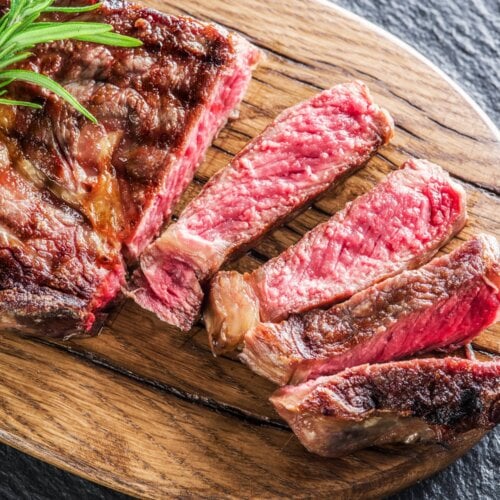
Grilling Ribeye
Ingredients
- 2 ribeye steaks
- kosher salt, to taste
- 2 tbsp olive oil
- 1 tbsp freshly ground black pepper
Instructions
- Remove steak from the refrigerator, and season generously with salt on both sides. Then, rest at room temperature for 45 minutes. Preheat the grill to 450-500 degrees. Brush 1 tbsp olive oil on the steaks and season steak with salt and pepper, if desired
- Place the ribeye steaks on the grill. Let sear for about 2-4 minutes until a golden-brown crust begins to form. Flip to the other side and sear for another 2-4 minutes
- Use a digital meat thermometer to check the internal temp of the thickest part of the meat. If more time is necessary, move steaks to a low-heat zone of the grill to let the steak cook for another 2-5 minutes
- Remove steaks from the grill and rest at room temperature on a plate tented with foil for 5-10 minutes before serving


